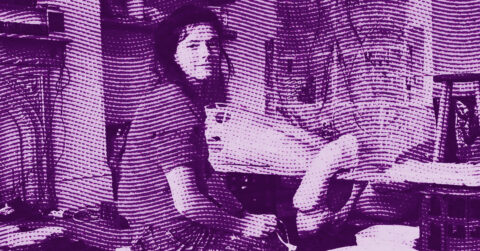Listen to me carefully, you bunch of snobs: Guy Yanai does not paint to flatter you. This man in his forties, born in Haifa and based between Tel-Aviv and Marseille, has developed over two decades a body of work that defies our most conventional expectations of what contemporary painting should be. Armed with his brush and his long horizontal stripes of color, Yanai transforms the ordinary into the extraordinary with a rigor that evokes both Byzantine mosaics and the pixelated screens of our smartphones.
The Israeli artist proceeds by accumulating horizontal touches, creating surfaces that seem woven rather than painted. This singular technique, gradually developed over the years, gives his canvases a particular materiality that oscillates between ancient craftsmanship and digital aesthetics. Each brushstroke becomes a unit of construction, a pixel of color that contributes to the building of a visual world that is both coherent and fragmented.
Yanai’s pictorial universe feeds on images gathered everywhere: Google Street View, TripAdvisor, Instagram, personal photographs, films by Éric Rohmer. This practice of appropriation is neither gratuitous nor lazy. On the contrary, it reveals a contemporary vision of artistic creation where the artist becomes, in his own words, more of an “editor” than a creator ex nihilo. This approach finds its justification in our era of visual overabundance, where the question is no longer how to create images, but how to choose and transform them.
Yanai’s subjects of predilection belong to what could be called the aesthetics of the international middle class: bright apartments with designer furniture, sailboats on peaceful lakes, sophisticated houseplants, hotel pools, windows open to Mediterranean landscapes. This imagery, far from being innocuous, constitutes the visual vocabulary of a certain globalized bourgeois modernity, that of decoration magazines and social networks. By appropriating these codes, Yanai does not criticize them directly, but transforms them into pictorial material, revealing their aesthetic as well as sociological dimension.
Architecture as an existential metaphor
The architectural approach in Guy Yanai far exceeds the simple representation of buildings. It constitutes a true system of visual thought that finds its roots in the theories of space developed by the architects and philosophers of the 20th century. The artist, who grew up in the particular architectural environment of Israel before settling in France, develops a particular sensitivity to questions of habitat and rootedness.
In his architectural works, Yanai implicitly dialogues with Le Corbusier’s reflections on the “machine for living in” and the standardization of domestic space. His interiors, whether they are Parisian apartments or Californian villas, reveal an international aesthetic standardization that transcends geographical borders. This homogenization of the inhabited space becomes for him the symptom of a contemporary condition: that of the modern man who can feel “at home” everywhere and nowhere at the same time.
Architecture in Yanai’s work also functions as a metaphor for identity construction. Born in Israel, raised in the United States, trained between New York and France, living today between Tel-Aviv and Marseille, the artist himself embodies this geographical mobility characteristic of our time. His paintings of interiors are never portraits of specific places but rather archetypes of habitable spaces, reduced models of what could be a universalizable “home”.
Yanai’s pictorial technique finds its most coherent expression in architecture. His horizontal stripes of color evoke the constructive elements of the building: bricks, concrete blocks, boards, cladding. This methodical approach to pictorial construction echoes architectural processes, where each element must find its place in a coherent structural whole. The artist, moreover, does not hide his admiration for the masters of modern architecture, particularly those who have been able to combine functionality and beauty.
This architectural dimension is also manifested in the way Yanai organizes the space of his canvases. Unlike painters who seek the illusion of depth, he favors a frontal approach that evokes architectural facades. His compositions are organized according to principles of symmetry and balance that recall the rules of classical architectural composition, while integrating a resolutely contemporary aesthetics.
The influence of the Bauhaus School, particularly present in the Israeli architecture of Tel-Aviv where the artist lives, is evident in this search for functional beauty. Yanai does not reproduce the forms of the Bauhaus, but updates their spirit: that of a democratic modernity that makes beauty an accessible good rather than an aristocratic privilege. This aesthetic philosophy is evident in the choice of his subjects, always drawn from the daily environment of the contemporary urban middle class.
The question of habitat in Yanai joins the existential concerns developed by Martin Heidegger in his reflection on being and space. But where the German philosopher questioned the authenticity of the traditional dwelling in the face of technical modernity, Yanai seems to accept and even celebrate this modernity. His interiors are not nostalgic for a bygone past but affirm, on the contrary, the possibility of a contemporary beauty, even in standardization.
The cinema of Éric Rohmer: a poetics of time and space
The influence of the French filmmaker Éric Rohmer on Yanai’s work constitutes one of the most enlightening keys to understanding his artistic approach. This filiation goes beyond the simple appropriation of cinematographic images to constitute a true method of work and an aesthetic philosophy. Rohmer, master of the French Nouvelle Vague, developed a cinema of the ordinary that finds in Yanai its most convincing pictorial transposition.
The Rohmerian aesthetic is based on a minute attention to the details of French bourgeois daily life. His films favor long dialogues in natural settings or carefully chosen interiors, creating an atmosphere of contemplative intimacy that deeply permeates Yanai’s work. The Israeli artist transposes this approach into painting by favoring apparently anodyne scenes: a woman reading near a window, a couple conversing on a dock, a Parisian interior bathed in morning light.
Rohmerian temporality, made of slowness and suspension, finds its pictorial equivalent in Yanai’s technique. His long horizontal stripes of color evoke the patience necessary for the construction of the image, creating a visual rhythm that recalls the particular cadence of Rohmer’s films. This laborious technique contrasts with the immediacy of the contemporary digital image, offering a time of contemplation that echoes that of the French filmmaker.
In “A Summer’s Tale” (1996) or “An Autumn Tale” (1998), Rohmer develops a sentimental geography of bourgeois France that fascinates Yanai. The artist draws from this imagery to create his own pictorial “tales”, where the places become the true protagonists of the works. His paintings of the Mediterranean coast, of Provençal terraces or of Parisian gardens update the Rohmerian universe by giving it an unprecedented plastic dimension.
Light occupies a central place in Rohmer, particularly in his last works where he explores the chromatic variations of the French seasons. Yanai transposes this luminous research by developing a characteristic color palette: Mediterranean blues, tender greens of the Parisian spring, powdery pinks of summer evenings. This Rohmerian chromatology becomes in him a full-fledged pictorial language, capable of evoking specific atmospheres and emotions.
Rohmer’s documentary approach, which often films real places with quasi-ethnographic precision, inspires Yanai’s working method. The artist collects images from his travels and internet discoveries with the same meticulousness as the filmmaker chose his sets. This accumulation of images becomes the basic material of a work that transforms the documentary into poetry, the factual into the dreamlike.
Rohmer’s moral philosophy, which examines with benevolence the small hypocrisies and great dreams of the French bourgeoisie, finds its counterpart in Yanai’s non-judgmental approach to his subjects. The artist never caricatures the middle-class universe he represents, but reveals, on the contrary, its potential beauty and emotional complexity. This aesthetic empathy constitutes one of the most touching aspects of his work.
Rohmer developed in his “Tales of the Four Seasons” a poetics of cyclical time that influences Yanai’s temporal conception. His paintings never represent precise historical moments but rather timeless instants, suspended in a bourgeois eternity that evokes the Rohmerian universe. This assumed atemporality allows his works to escape the contingencies of current events to reach a form of contemporary universality.
The economy of means characteristic of Rohmer’s cinema also inspires Yanai’s minimalist approach. Like the filmmaker who created masterpieces with meager budgets, the artist manages to create works of great emotional richness with deliberately limited pictorial means: a few colors, a repetitive technique, apparently simple subjects. This aesthetic of restraint constitutes one of the main strengths of his work.
Contemporary synthesis
Guy Yanai operates a remarkable synthesis between pictorial tradition and contemporary sensibility. His technique, inherited from the pointillists but updated by digital aesthetics, creates works that speak simultaneously to our contemporary eye accustomed to screens and to our artistic culture nourished by the history of painting. This dual belonging constitutes the main originality of his approach and explains the international success he enjoys today.
The artist fully assumes his condition as a man of his time, using the internet as a gigantic imaginary museum from which to draw his inspirations. This approach, which would have horrified yesterday’s purists, reveals an intelligence of the era that makes Yanai one of the most relevant painters of his generation. As he himself points out: “I am sure that Matisse would do the same thing. Really. You have all these visual things everywhere” [1].
This freedom in the appropriation of sources is accompanied by a technical rigor that prevents the work from falling into facility. Each of Yanai’s paintings testifies to a considerable temporal and emotional investment, an attention to detail that transforms the appropriated image into an original creation. The slowness of his creative process salutarily contrasts with the rapidity of the circulation of contemporary images, proposing a time of art that resists the general acceleration of our societies.
Yanai’s work also raises the question of artistic identity in a globalized world. An Israeli artist trained in the United States, living between France and Israel, exhibiting in the world capitals of contemporary art, he embodies a new generation of artists for whom geographical rootedness is no longer a necessary condition for creation. This assumed nomadism nourishes his work with a cultural richness that transcends national particularisms.
The critical reception of Yanai’s work reveals the tensions of our artistic era. Some see in it a naive celebration of the Western bourgeois way of life, others a subtle critique of contemporary aesthetic standardization. This ambiguity probably constitutes one of the strengths of his work: refusing the facility of explicit denunciation as well as decorative complacency, it proposes a middle way that questions our relationship to contemporary beauty.
The future of this work will probably depend on its ability to maintain this delicate balance between accessibility and demand, between anchoring in the era and timelessness. The recent evolutions of his work, notably the introduction of human figures and the exploration of new formats, suggest an artistic maturity that augurs stimulating evolutions.
Guy Yanai represents this generation of artists who have been able to transform the challenges of the contemporary era into creative opportunities. His work demonstrates that it is possible to create authentic and personal painting in a world saturated with images, provided that one accepts the rules of the contemporary game while maintaining a high artistic demand. This lesson, dispensed with elegance and without dogmatism, probably constitutes the most precious teaching of his work.
- Chernick, Karen. Article “Guy Yanai’s Painting Practice Was Made for This Moment“, published on artsy, April 13, 2020.
















